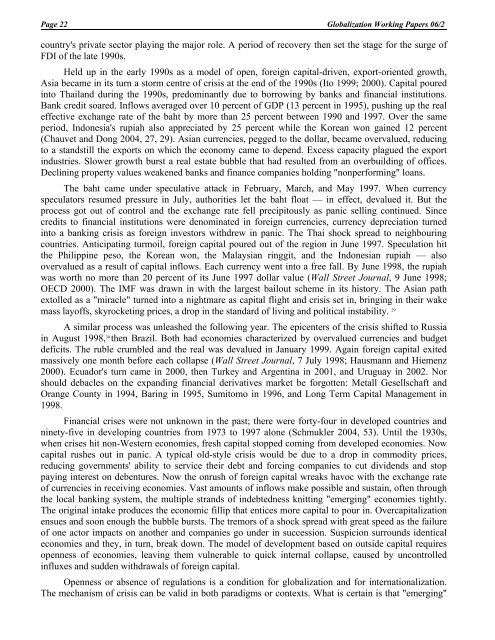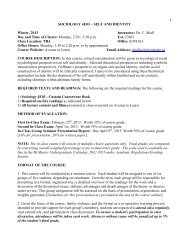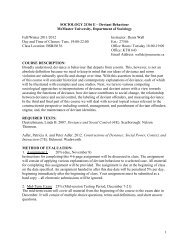samir saul2 sz.pub - Faculty of Social Sciences - McMaster University
samir saul2 sz.pub - Faculty of Social Sciences - McMaster University
samir saul2 sz.pub - Faculty of Social Sciences - McMaster University
Create successful ePaper yourself
Turn your PDF publications into a flip-book with our unique Google optimized e-Paper software.
Page 22 Globalization Working Papers 06/2<br />
country's private sector playing the major role. A period <strong>of</strong> recovery then set the stage for the surge <strong>of</strong><br />
FDI <strong>of</strong> the late 1990s.<br />
Held up in the early 1990s as a model <strong>of</strong> open, foreign capital-driven, export-oriented growth,<br />
Asia became in its turn a storm centre <strong>of</strong> crisis at the end <strong>of</strong> the 1990s (Ito 1999; 2000). Capital poured<br />
into Thailand during the 1990s, predominantly due to borrowing by banks and financial institutions.<br />
Bank credit soared. Inflows averaged over 10 percent <strong>of</strong> GDP (13 percent in 1995), pushing up the real<br />
effective exchange rate <strong>of</strong> the baht by more than 25 percent between 1990 and 1997. Over the same<br />
period, Indonesia's rupiah also appreciated by 25 percent while the Korean won gained 12 percent<br />
(Chauvet and Dong 2004, 27, 29). Asian currencies, pegged to the dollar, became overvalued, reducing<br />
to a standstill the exports on which the economy came to depend. Excess capacity plagued the export<br />
industries. Slower growth burst a real estate bubble that had resulted from an overbuilding <strong>of</strong> <strong>of</strong>fices.<br />
Declining property values weakened banks and finance companies holding "nonperforming" loans.<br />
The baht came under speculative attack in February, March, and May 1997. When currency<br />
speculators resumed pressure in July, authorities let the baht float — in effect, devalued it. But the<br />
process got out <strong>of</strong> control and the exchange rate fell precipitously as panic selling continued. Since<br />
credits to financial institutions were denominated in foreign currencies, currency depreciation turned<br />
into a banking crisis as foreign investors withdrew in panic. The Thai shock spread to neighbouring<br />
countries. Anticipating turmoil, foreign capital poured out <strong>of</strong> the region in June 1997. Speculation hit<br />
the Philippine peso, the Korean won, the Malaysian ringgit, and the Indonesian rupiah — also<br />
overvalued as a result <strong>of</strong> capital inflows. Each currency went into a free fall. By June 1998, the rupiah<br />
was worth no more than 20 percent <strong>of</strong> its June 1997 dollar value (Wall Street Journal, 9 June 1998;<br />
OECD 2000). The IMF was drawn in with the largest bailout scheme in its history. The Asian path<br />
extolled as a "miracle" turned into a nightmare as capital flight and crisis set in, bringing in their wake<br />
mass lay<strong>of</strong>fs, skyrocketing prices, a drop in the standard <strong>of</strong> living and political instability. 29<br />
A similar process was unleashed the following year. The epicenters <strong>of</strong> the crisis shifted to Russia<br />
in August 1998, 30 then Brazil. Both had economies characterized by overvalued currencies and budget<br />
deficits. The ruble crumbled and the real was devalued in January 1999. Again foreign capital exited<br />
massively one month before each collapse (Wall Street Journal, 7 July 1998; Hausmann and Hiemenz<br />
2000). Ecuador's turn came in 2000, then Turkey and Argentina in 2001, and Uruguay in 2002. Nor<br />
should debacles on the expanding financial derivatives market be forgotten: Metall Gesellschaft and<br />
Orange County in 1994, Baring in 1995, Sumitomo in 1996, and Long Term Capital Management in<br />
1998.<br />
Financial crises were not unknown in the past; there were forty-four in developed countries and<br />
ninety-five in developing countries from 1973 to 1997 alone (Schmukler 2004, 53). Until the 1930s,<br />
when crises hit non-Western economies, fresh capital stopped coming from developed economies. Now<br />
capital rushes out in panic. A typical old-style crisis would be due to a drop in commodity prices,<br />
reducing governments' ability to service their debt and forcing companies to cut dividends and stop<br />
paying interest on debentures. Now the onrush <strong>of</strong> foreign capital wreaks havoc with the exchange rate<br />
<strong>of</strong> currencies in receiving economies. Vast amounts <strong>of</strong> inflows make possible and sustain, <strong>of</strong>ten through<br />
the local banking system, the multiple strands <strong>of</strong> indebtedness knitting "emerging" economies tightly.<br />
The original intake produces the economic fillip that entices more capital to pour in. Overcapitalization<br />
ensues and soon enough the bubble bursts. The tremors <strong>of</strong> a shock spread with great speed as the failure<br />
<strong>of</strong> one actor impacts on another and companies go under in succession. Suspicion surrounds identical<br />
economies and they, in turn, break down. The model <strong>of</strong> development based on outside capital requires<br />
openness <strong>of</strong> economies, leaving them vulnerable to quick internal collapse, caused by uncontrolled<br />
influxes and sudden withdrawals <strong>of</strong> foreign capital.<br />
Openness or absence <strong>of</strong> regulations is a condition for globalization and for internationalization.<br />
The mechanism <strong>of</strong> crisis can be valid in both paradigms or contexts. What is certain is that "emerging"




